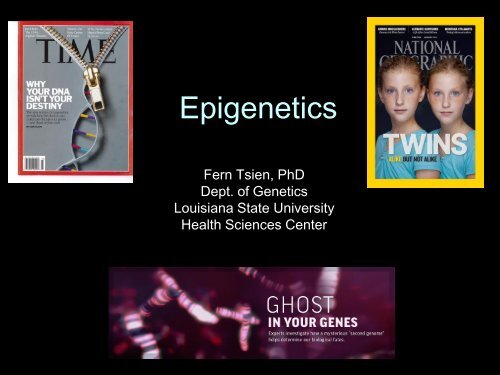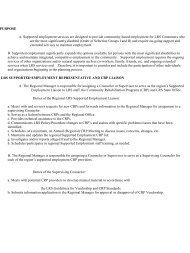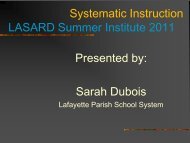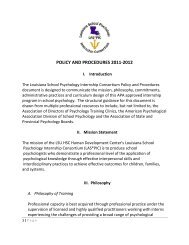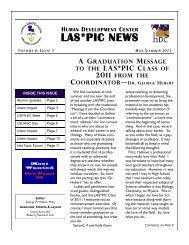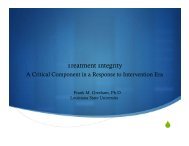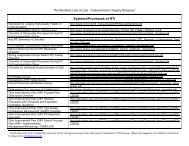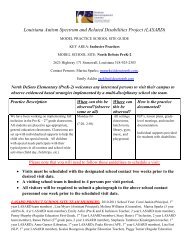Epigenetics - LSUHSC Human Development Center
Epigenetics - LSUHSC Human Development Center
Epigenetics - LSUHSC Human Development Center
Create successful ePaper yourself
Turn your PDF publications into a flip-book with our unique Google optimized e-Paper software.
<strong>Epigenetics</strong>Fern Tsien, PhDDept. of GeneticsLouisiana State UniversityHealth Sciences <strong>Center</strong>
ICC policy statementSixth WTO Ministerial ConferenceIt is incumbent upon all WTO members to ensure that the Hong Kong MinisterialConference achieves meaningful results and locks-in further progress, in order tomaintain momentum for achievement of a final result by the end of 2006. This must ofnecessity mean agreement on all modalities.It will be essential, in our view, for ministers and capitals to stay strongly engaged and togive Geneva Ambassadors clear negotiating mandates to ensure steady progress betweennow and the Hong Kong Ministerial. The progress achieved at recent “mini-ministerial”meetings attests to the benefit of such high-level engagement.The rules-based multilateral trading system must improve its capacity to keep up withthe pace of global economic developments and new business realities by deliveringmeaningful results as rapidly as possible. This is all the more important since updatedmultilateral disciplines are necessary to maintain a liberalizing influence on theburgeoning number of bilateral and regional trade agreement, to safeguard the integrityof the multilateral trading system and the principle of non-discriminatory trade. Only anexpeditious and successful conclusion of the Doha round that achieves substantial tradeliberalization can mitigate the trade diverting effects of bilateral and regional tradeagreements.While making progress on agriculture will be necessary for progress in other areas, WTOmembers should strive to move forward in parallel the key elements of the Doha agendamentioned above, in order to facilitate the give-and-take across negotiating subjects thatwill make it possible to reach a balanced overall result. For example, this means thatwork on services must be accelerated to maintain true parallel progress because thecomplex procedures of that negotiation take more time to complete.Special efforts are required to facilitate the participation of developing countries,particularly the least developed among them, in the multilateral trading system. It is vitalthat the results of the Doha round create meaningful opportunities for increased exportsfrom the least developed countries. Through increased exports, least developedcountries will be able to benefit from the opportunities offered by trade liberalization andglobalization.- 3 - World business and the multilateral trading system
Genomic imprinting
Genomic imprinting1 2 3 4 5• Normally, we all inherit two copies of every gene,one copy from our mother and one from our father.• Both copies are functional for the majority of thesegenes.6 7 8 9 10 11 1213 14 15 16 17 1819 20 21 22X Y• However, a proportion of genes are imprinted, meaning that eitherthe copy from mom or the copy from dad is epigenetically silenced.• These genes are called 'imprinted' because one copy of the genewas epigenetically marked or imprinted in either the egg or thesperm.• In genomic imprinting, the gene expression is different if it ismaternally derived or the paternally derived EVEN THOUGHTHEIR DNA SEQUENCE IS EXACTLY THE SAME.• Imprinted expression can also vary between tissues and embryonicdevelopmental stages
<strong>Human</strong> Genomic Imprinting Map
Genomic imprinting• Therefore, genomic imprintingviolates the Mendelian rulewhich states that dominanceof one genetic allele overanother is an inherent functionof the alleles themselves, anddoes not depend upon theparent of origin of the allele.Drat!
Genomic imprinting• Is necessary for the developing embryo.• Completion of embryogenesis requires both thedifferential maternal and paternal genomicexpressions.• No mammalian species is known to useparthenogenesis as a naturally occurring reproductivemethod.(exception: animal cloning)• Parthenogenesis is the natural production of offspringby a female, without a male genetic contribution.
Understanding genomicimprinting in embryogenesis• In mice, artificial generation of androgenote andgynogenote embryos by oocyte microinjectionand transfer.• Gynogenotes are produced in the lab byremoving fertilized oocytes from a female mouseprior to the fusion of the male and femalepronuclei• Androgenotes are made in a similar way, exceptthat the maternal-derived nucleus is removedand replaced with another male-derived nucleus
Pipetfertilized oocyteremove 1 nucleusPipetinject new nucleusPipetMaking a gynogenote(All genomic material from female germline)
Pipetfertilized oocyteremove 1 nucleusPipetinject new nucleusPipetMaking an androgenote(All genomic material from male germline)
fertilized oocyte• Double-maternal embryos failto develop significant extraembryonicstructures.• The embryo-proper growsfairly well.Gynogenote developm entExtraembryonic tissues = FAILEmbryonic tissues = OK
fertilized oocyteAndrogenote developm entExtraembryonic tissues =Embryonic tissuesO = KFAIL• Double-paternal embryosdevelop primarily as extraembryonicstructures, suchas the placenta.• The embryo itself fails todevelop past an early stage.• Therefore, while bothgenomes appear necessaryfor normal embryogenesis,they are not equivalent ineffect.
CONCLUSIONCompletion of embryogenesis requires both the maternal andpaternal genomes.
Androgenesis and Parthogenesisand Genomic Imprinting in <strong>Human</strong>sOVARIAN DERMOID CYSTSAll female derived geneticmaterial. Can result from spontaneousovarian oocyte activation with duplication ofthe maternal genome.HYDATIDIFORM MOLEAll male derived geneticmaterial. An enucleate egg is fertilized bya haploid sperm (which then duplicates itschromosomes), or the egg is fertilized by 2sperm. A complete mole contains no or littlefetal tissue and hyperplastic extra embryonicgrowth.
What controls epigenetics andgenomic imprinting?
What controls epigenetics andgenomic imprinting?DNA methylation changesHistone modificationsHistone acetylationHistone methylationHistone phosphorylationHistone ubiquitination Changes in chromatin structure are affected by DNAmethylation and histone modifications. microRNAsPolycomb group proteinsPrions
ImprintestablishmentandpropagationImprint must bemaintained insomatic cell divisionImprint must beerasable in germlinewhen transmittedthrough opposite sex
DNA methylation
DNA MethylationCCDNA methylation refers to the transfer of a methyl (-CH3) group by S-adenosyl-L-methionine (SAM) to a DNA base.In humans, DNA methylation is limited to the C-5 position of cytosineresidues resulting in 5-methylcytosine (m5C).The reaction is catalyzed by a DNA methyltransferase (DNMT), with SAM as amethyl donor.
DNA methylation turns genes on or off• Non-methylated or hypomethylatedDNA sequences are usuallyexpressed• Highly methylated(hypermethylated) DNA sequencesare usually not expressedGeneHypo-MethylationHyper-MethylationTherefore,↑ DNA methylation, ↓gene expression↓ DNA methylation, ↑ gene expression
DNA methyl groups can directly interfere withbinding of transcription factors to DNAAn untwisted double strand of DNAshowing several cytosine sequencesmethylated on both strands.3-D model of DNA with methyl groups inred.
Global CpG methylation in humans• Postnatal somatic tissues are highlymethylated (~90%)• Term placenta (65%)• Sperm (70%)• The hypomethylation of placenta andsperm is due to the embryonic origin ofplacenta and the germline origin of sperm
DNA Methylation and CancerAbnormal Hypermethylation ofTumor suppressor genesTumor Suppressor genes are normallysupposed to be turned on or hypomethylatedto stop or suppress cancer.However, if they become abnormallyhypermethylated they can lead to humancancerNormal tumorsuppressor geneTranscriptional silencing of tumor suppressorgenes associated with DNA hypermethylationis a common epigenetic event in hematologicmalignancies (leukemias) and in early breastcancer.Tumor suppressorgene is turned offduring cancer
Turning on of abnormallyinactivated tumor suppressorgenes5-aza-2′-deoxycytidine (also calledDecitabine) has both a hypomethylatingeffect at low doses when incorporated intoDNA and a cytotoxic effect at higher dosesas a result of interfering with translationwhen incorporated into RNA.Used for chemotherapy for leukemias.
DNA Methylation and CancerAbnormal Hypomethylation ofOncogenes•Oncogenes are normally turned on duringembryogenesis but are supposed to beturned off after birth and hypermethylatedwhen there is no need for such rapid cellgrowth.Abnormal turning on of these oncogenesthrough mutations or hypomethylation leadsto cancer.OncogeneduringembryogenesisOncogeneduringchildhood andadulthoodOncogene duringcancerMost human tumors often exhibit overallgenome hypomethylation relatively early invarious types of carcinogenesis
Histone modifications
Chromatin:DNA, Histones,and non-histoneproteins
DNA winds around the histones
Compaction of DNA• Histone proteins havea positive charge ontheir lysine-richamino-terminal tails• This makes a majorcontribution toneutralizing thenegative charge of theDNA backbone andfacilitatingcompaction.- charge+ charge
• Acetylation (addition of aCOCH 3 ) to histoneproteins removes positivecharges, therebyreducing the affinitybetween histones andDNA.• This makes RNApolymerase andtranscription factorseasier to access thepromoter region of DNA.• Therefore, in most cases,histone acetylation turnsgenes on• while histonedeacetylation turns genesoffAcetylation anddeacetylation of thelysine residueGene offGene onHistone acetylation is catalyzed byhistone acetyltransferases (HATs) andhistone deacetylation is catalyzed byhistone deacetylases (denoted by HDsor HDACs).
HDAC inhibitors (HDI)• Trichostatin A (TSA) and valproic acid are of the twomain groups of histone deacetylase inhibitors (HDI)which alter gene expression by interfering with histonedeacetylases (HDAC).• The classical HDIs act by binding to the zinc containingcatalytic domain of the HDACs.• HDIs have a long history of use in psychiatry andneurology as mood stabilizers and anti-epileptics• Also in recent years, there has been an effort to developHDIs as a cancer treatment (SAHA and TSA).****Therefore:• Histone acetylation actives gene• Histone deacetylase (HDAC) inactivates the gene• Histone deacetylase inhibitor (HAD such as TSA)reactivates the gene
Imprinting and diseaseAbnormal imprinting ofspecific gene regions
<strong>Human</strong> Imprinting Map
Prader-Willi syndrome -• first humandisorder attributedto genomicimprinting• diminished fetalactivity, obesity,hypotonia, mentalretardation, shortstature,hypogonadism, andsmall hands andfeet.PWS
Angelman syndrome -AS• ‘Happy Puppet’• severe motor andintellectual retardation,ataxia, hypotonia,epilepsy, absence ofspeech, and unusual facescharacterised by a largemandible and openmouthedexpressionrevealing the tongue• laughter
Both PWS and AS arecaused byabnormalities of thesame chromosome 15region q11.2-q13.1
Pathogenic mechanisms in PWS and ASIIISNRPNP15PWSASPWS + AS -M15IIIPWSUBE3AASPWS - AS +IIIImprinting centre
Prader-Willi syndromeIIISNRPNPWSP15PWSASPWS + AS -M15PWSASPWS - AS +I III IIP1575%15q11-q13M15 PWSASPWS - AS + deletionIIIIIIM15M15PWSPWSASASPWS - AS +~20%UPDPWS - AS +IIIP15M15IIIPWSPWSASAS~2%PWS - AS +ImprintingPWS - AS + errorIII
Angelman syndromeIIIASP15PWSASPWS + AS -M15PWSASPWS - AS +IIIUBE3AP15M15IIIPWSAS75%PWS + AS -PWS - AS deletion+IIIP15P15 M15IIIPWSPWSASASPWS + AS 3%-UPDPWS + AS -IIIP15M15IIIIIIPWSPWSASAS~5%PWS + AS -ImprintingPWS + AS - error
****Imprinting mechanism ofPWS and AS• Prader Willi: caused by loss of paternal15q11.2-q13.1 expression• Angelman caused by loss of maternal15q11.2-q13.1 expression
How can epigenetics affectYOU????
Environment• A growing number of animal studies showthat parental diet and other exposures caninfluence fetal DNA methylation patternsand permanently affect health outcomes inlater life.• Environmentally induced changes in DNAmethylation patterns are heritable acrossgenerations• Twin studies
<strong>Epigenetics</strong> and environment• Pharmaceuticals, pesticides, air pollutants,industrial chemicals, heavy metals, hormones,and nutrition can change gene expressionthrough a broad array of gene regulatorymechanisms.• These chemically induced changes in generegulation are associated with serious andcomplex human diseases, including cancer,diabetes, infertility, respiratory diseases,allergies, and neurodegenerative disorders suchas Parkinson and Alzheimer diseases.• One of the best-studied areas of gene regulationis epigenetics, especially DNA methylation.
Interconnecting folateand methyl metabolism•<strong>Human</strong>s ingestapproximately 50 mmol ofmethyl groups per day.**•****Folic acid is found in vegetables(broccoli, Brussels sprouts, spinach,etc).•Choline is mainly found in egg yolks,meat, and wheat germ•Of interest is the role offolate metabolism as amethyl source enablinghomocysteine to convert tomethionine, which in turnleads to the production ofSAM, the principal methyldonor and precursor forDNA methylation.Such a change is expectedto affect DNA methylationvia the concentrations ofSAM and SAH.
Environment• A growing number of animal studiesshow that parental diet and otherexposures can influence fetal DNAmethylation patterns and permanentlyaffect health outcomes in later life.
Twin studies• Many reports of twins with discordantaging phenotypes• One report: both twins developedhistologically confirmed dementia of theAlzheimer's type; one had the diagnosis inher late 60s but the other was notdiagnosed until age 83• Environmental effects or epigenetics?• Both
Identical twins:• Same genotype• Differentphenotype• Differentepigenotype
Epigenetic twin studies•Investigators report both global and locus-specific differences in DNAmethylation and histone acetylation in identical twins of various ages.•Their general conclusion is that young identical twin pairs are essentiallyindistinguishable in their epigenetic markings, older identical twin pairs showsubstantial variations.
<strong>Epigenetics</strong>•These are two identical twin mouse sisters.•The yellow mouse below is obese and diabetic.•The brown mouse remains slender and lean and also has a lower risk ofdeveloping disease.-> Differences in the expression of the agouti coat color genes can beexplained by EPIGENETICS.They are GENETICALLY the same, EPIGENETICALLY different.Has been exposedto BPA and hasabnormalhypomethylation ofmany of its genesHas mormal DNAmethylation levels
<strong>Epigenetics</strong>• Found in different organisms• Changes in chromatin structure are affected byDNA methylation and histone modifications.• Important for gene expression duringembryogenesis• Involved with tumor formation, variousimprinting disorders, and aging• Cloning experiments, gene therapy experimentsmay be affected by epigenetics
Thank you!!!!


